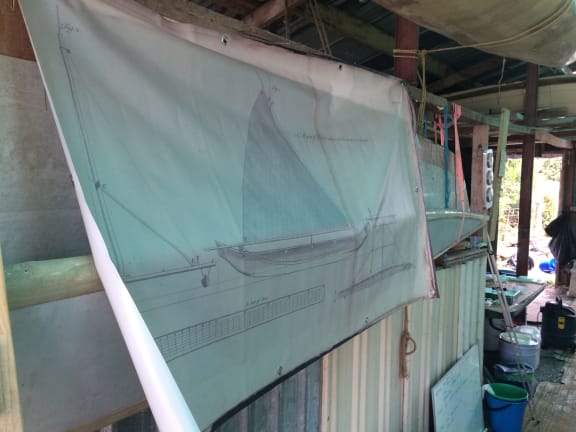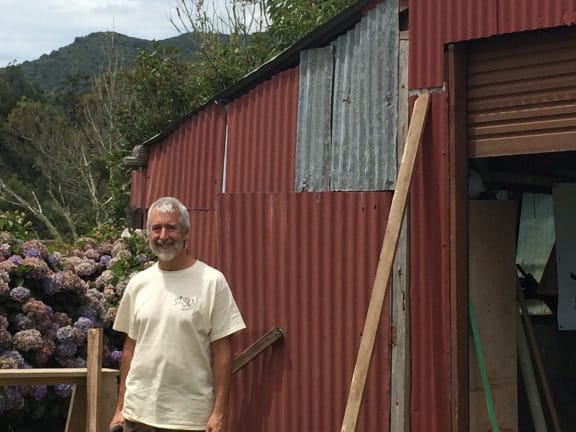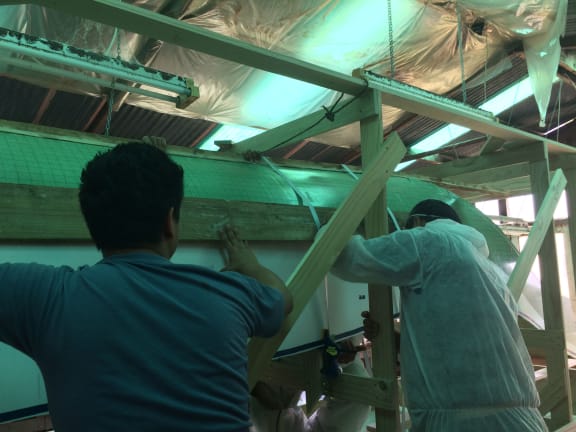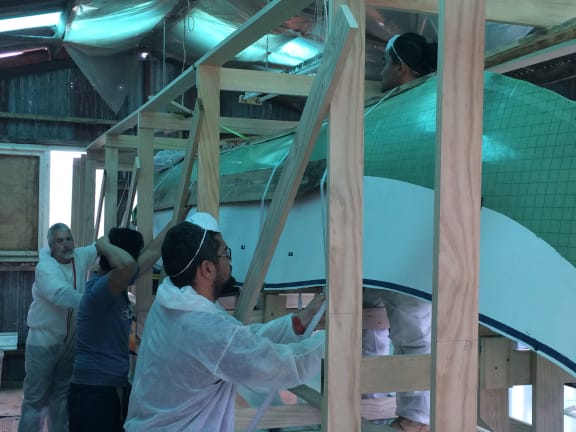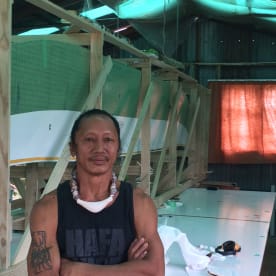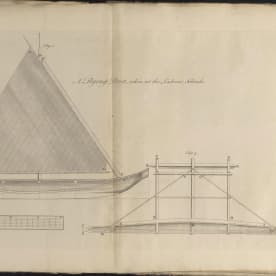The dark red shed is nestled inconspicuously between parched rolling hills on the edge of a shallow stream, its dribble of water slowly meandering its way through the golden countryside near Waihi, at the base of the Coromandel Peninsula in New Zealand's North Island.
To find the corrugated iron shed involved a level of navigation Kupe himself would have been proud of. Sitting hidden behind a bush along a narrow road winding its way to base of the jagged, monster tooth-like Kaimai Ranges, a towering backdrop to the drive along the maze of roads that criss-cross and weave their way past the ruins of a mining heyday and paddocks dotted with sheep and driveway stands.
"AVOCADOS $2" "HORSE POO $1," the roughly hand-painted signs along the way all declared.
It seemed the most unlikely of places, but this shed is the base for an ambitious project to restore the maritime culture of the Chamorro people of the Northern Marianas and Guam, a culture long feared to be dead.
Inside, there was grunting and swearing as eight men in white overalls lifted a piece of fibreglass as long as the shed up onto a wooden frame before trying to bend it around to reach another length of fibreglass.
"This will eventually be the hull," said Pete Perez, the executive director of the Saipan-based organisation 500 Sails, which is leading the project to recreate a traditional Chamorro canoe, known as a proa.
Mr Perez and seven other Chamorro people from the Northern Marianas and Guam have travelled to New Zealand, a journey of some 6000km, and they are camping on the property of the Waihi-based boat builder Derek Kelsall for a month. They were two weeks into their stay when I visited, and had yet to leave Mr Kelsall's section.
"It's been going all right, we've had our ups and downs," Mr Perez said.
"This is our prototype. We've learned a lot from building it, like that I lofted it wrong. So we're working around that problem."
The group had two weeks left to finish the hull, attach an outrigger, create a sail and then put it all together, before testing it on the water.
That meant there was little time for sightseeing. The eight boat builders from the Marianas, plus Mr Kelsall and another New Zealand-based boat builder, Marc Dutilloy, would spend as long as 12 hours a day working in the sweltering summer heat in the shed, a 20-step walk across a small courtyard from Mr Kelsall's house where they eat and sleep.
It was a bustling hive of activity, with the men scurrying about like a pack of worker ants as they laboured to fix the frame and haul the fibreglass. A gentle summer breeze blowing through the entrance did little to ease the searing heat, as they lined along each side of the fibreglass.
"Three! Two! One!" they called before tugging at ties to try and bend it into a curved hull shape. Between each attempt, a small head with long straggly hair and a stubbly beard popped up from behind the fibreglass to bark orders in a thick French accent.
"Release the tension. Be careful with your edge. Don't let it twist," ordered Mr Dutilloy, who was leading the construction.
"It's moving, you need to bring it up a bit," he said, pointing to Mr Perez, who was pushing his shoulder into the fibreglass with what, according to the grimace on his face, looked like his full force.

Pete Perez Photo: RNZ/ Jamie Tahana
"I've never actually built a canoe before," admitted Mr Dutilloy with a wide grin. "I've always been interested and I found out about this on the internet one night ... I got in touch, and here I am, leading it."
Mr Dutilloy offered the team as much sarcasm and acerbic wit as he did construction advice, but in a form of organised chaos, things were going well, he said.
"Who's got the drill?" asked one of the men.
"There's a bulge in the fibreglass here, should we worry about that?" asked another.
"Probably," replied Mr Dutilloy.
"Is it lunch time yet?"
"Yes," they all concurred before downing tools and charging into the house for bacon sandwiches.
For Mr Perez, his objective is to create a prototype proa in Waihi to take back to Saipan, the main island of the Northern Marianas, a United States territory in the Northern Pacific, to build 499 more. With these, Mr Perez said, the group hopes to revive a maritime culture that was lost under Spanish occupation hundreds of years ago.
"This was during the Spanish colonial times when the Spanish really took advantage of the situation and they used the Chamorro for pretty much forced labour. In fact, the Spanish took them all off 14 islands and put them all on one island, Guam."
Spanish occupation of the Marianas, from 1668 to the end of the Spanish-American war in 1898, was brutal. The native Chamorro and Carolinian people were forced onto Guam where they were converted to Catholicism, many were forced into labour, and a majority of the population died from Spanish-introduced diseases. It was during this occupation that the Chamorro, a sea-faring culture like many others in the Pacific, lost their oceanic ways.
"Every time the Chamorro's would get in their proas and leave to go to the Northern islands, the Spanish would have to chase them down," said Mr Perez.
"So they forbade the Chamorro from going off the reef and from building canoes that were capable of going off the reef. After a short time - a few generations - the knowledge was lost. The knowledge of building the big canoes and sailing the big canoes was lost.
"There were no models left, only some rough sketches," Mr Perez said, which meant that some 350 years later, Chamorro ancestors were left struggling to find any trace of where to start in order to rekindle their sailing ways.
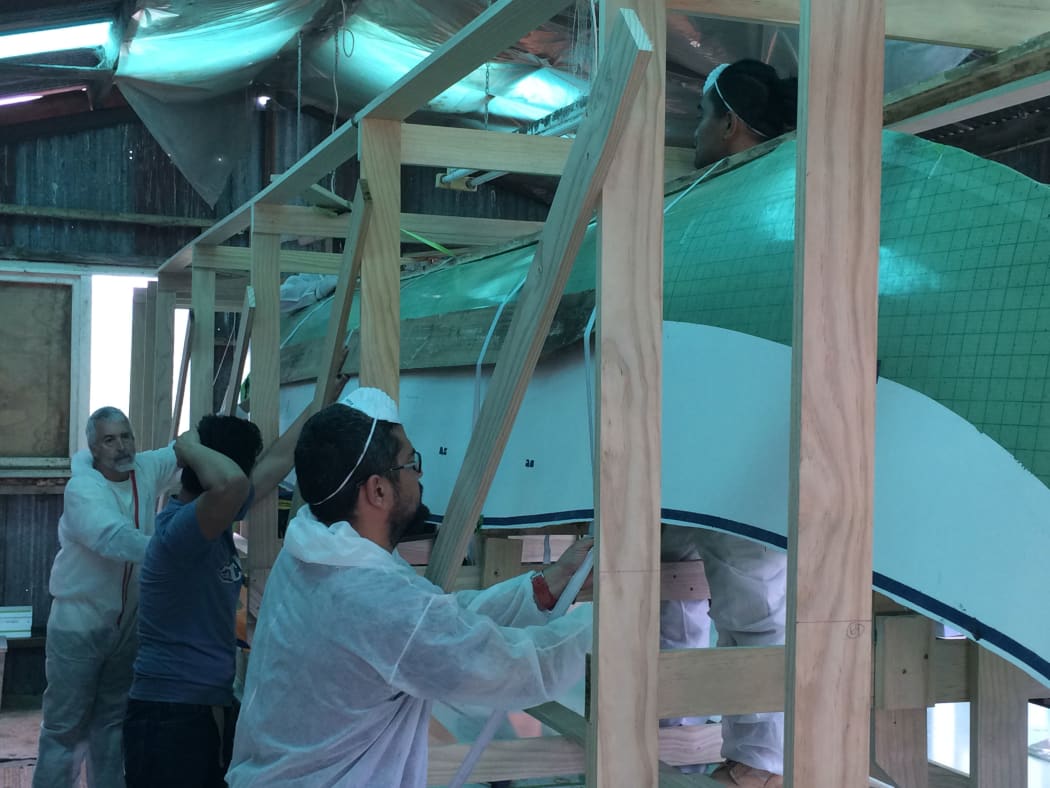
The team works on the canoe. Photo: RNZ/ Jamie Tahana
Fortunately, in the 18th century, when the British naval Commodore George Ansell embarked on his four-year-long voyage around the world, his ship the Centurion sustained damage on a particularly treacherous voyage across the Pacific from South America. In August 1742, it managed to anchor off the island of Tinian, which lies between Saipan and Guam, where it stayed for three months for repairs.
While there, an officer on board the ship, Peircy Brett, took apart a proa, made measurements, and sketched out a detailed plan of it. This sketch is believed to be the only remaining detailed blueprint for the Chamorro proa.
More than two centuries - and three colonial masters - later, Ron Acfalle, a slightly built Chamorro elder with long black hair pulled back into a ponytail, decided he wanted to recreate the proa.
"It took a lot of reading up, a lot of research work and basically just getting a lot of information from the old archive that the Europeans had left behind," he said.
"I had a bit of help from some people out at the Caroline Islands who showed me how to carve and what tools to use. Since then, I've been wanting to learn how to build our traditional canoe."
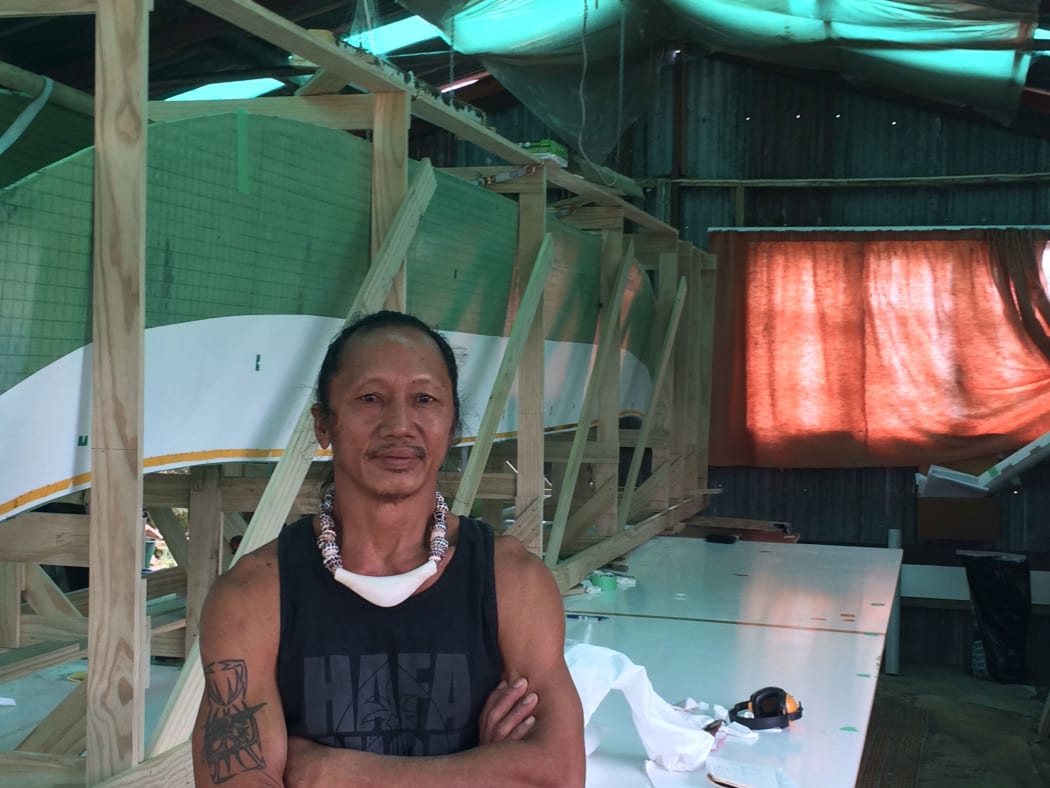
Ron Acfalle Photo: RNZ/ Jamie Tahana
Using Peircy Brett's sketch, Mr Acfalle searched across Guam for the right trees, chopped them down and then carved them into three canoes. In 2016, after eight months of building, Mr Acfalle and a group of apprentices sailed into the opening ceremony for the Festival of Pacific Arts to thunderous applause from crowds that had gathered from across the Pacific.
"Ron's probably the first Chamorro to build a proa in more than 200 years," Mr Perez said.
"It's amazing."
A large poster of Mr Brett's sketch hung on the wall of the sweltering shed in Waihi, looking down on the workspace like some kind of religious monument as its followers tried to recreate its image. Mr Acfalle had joined the 500 Sails team as an advisor, as they worked out how to build a proa from fibreglass - not the most traditional of Chamorro materials.
"The wooden proa is a great and beautiful boat, but it cost $US60,000 to build that boat and after all the materials were there it took a year," Mr Perez said.
"But with fibreglass we can build an entire boat for probably under $US3000 and we can build the whole boat in under two weeks - so that's the difference.
"Besides, if you took a Chamorro wooden proa and you sailed it and you pulled it up onto the beach when you were done. If you left it there, a year later it would be unusable because of the termites and other kinds of insects. But with these proas you could leave it in your yard for 10 years."

The team works on the canoe. Photo: RNZ/ Jamie Tahana
That's what led the group from the Marianas islands to seek out Mr Kelsall in Waihi. An expert fibreglass boat builder, Mr Perez said they felt confident he could help create the prototype of the 21st century proa from fibreglass, bamboo and a polyethylene tarpaulin sail - a cheap and durable version that could be used to teach hundreds of young Chamorro how to sail, bringing the indigenous people of the Marianas back to the sea and, with that, creating avenues of employment and opportunity for a population with high levels of unemployment and poor health.
But Mr Acfalle, very much a traditionalist, was reluctant in his embrace.
"I don't like working with fibreglass," he said, tapping the frame of the barely-assembled hull.
"I like taking kids into the jungle and showing them how to select a certain tree and how to cut it down, take it out and then how to look at it and then feel the tree and then carve it - that's my passion."
"But, being that it takes so long to build, there a lot of younger generation that are hungry to learn this knowledge and it's hard to do it with just a small number of canoes. So, having this opportunity to learn how to build with fibreglass will probably make it a lot easier for me to teach so that I can have more canoes out on the water and then teach more kids."
Having talked at length about how the Chamorro had lost their proa, their navigation skills, and their sea-faring culture, Mr Acfalle paused for a moment, folded his arms and stared at the frame and Peircy Brett's sketch, pinned to the side of the shed, rustling in the slight breeze as the cicadas roared in the height of the summer sun.
"It's amazing, honestly," he said with a smile.
"We don't know what it is yet, we haven't mastered it. But I think we're close to knowing how our ancestors sailed their canoes."
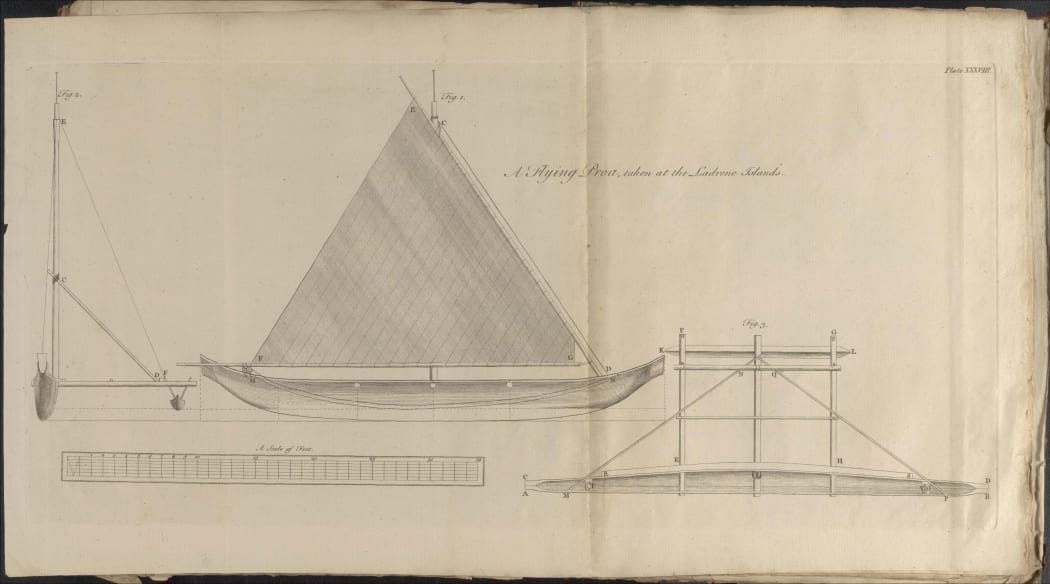
Anson Drawing made in 1742 during the round-the-world voyage of the English ship Centurion. Photo: supplied/ 500 Sails

